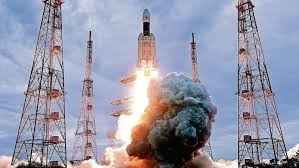TECHNOLOGICAL ADVANCEMENTS OF INDIA
 The Government of India has actively supported technological growth through various initiatives and policies. Programs like Make in India, Digital India, and Startup India have created a conducive environment for innovation, entrepreneurship, and industrial development. Increased investments in research and development (R&D) and strong public-private partnerships have further boosted India’s technological capabilities. These efforts have positioned India as a rising global leader in science and technology, contributing to economic growth and addressing social challenges.
The Government of India has actively supported technological growth through various initiatives and policies. Programs like Make in India, Digital India, and Startup India have created a conducive environment for innovation, entrepreneurship, and industrial development. Increased investments in research and development (R&D) and strong public-private partnerships have further boosted India’s technological capabilities. These efforts have positioned India as a rising global leader in science and technology, contributing to economic growth and addressing social challenges.
In the following sections, we will explore the key areas of technological advancement in India, including government policies and strategies aimed at driving progress and ensuring the nation’s position as a global leader in technology.
Space Technology
India’s space technology journey began with the establishment of ISRO in 1969, leading to remarkable achievements in space exploration. ISRO’s successful missions and strong space infrastructure reflect India’s commitment to scientific research and technological advancement. This progress has enhanced national development and strengthened India’s position in global space exploration.
- Establishment of ISRO (1969): The formation of ISRO in 1969 under the leadership of Dr. Vikram Sarabhai laid the foundation for India’s space program. ISRO’s initial focus was on the development of indigenous satellite and launch vehicle technology. The organization aimed to use space technology for national development, including telecommunications, weather forecasting, and navigation.
| JOURNEY OF ISRO |
|
India’s space journey began in 1962 with the establishment of the Indian National Committee for Space Research (INCOSPAR), laying the foundation for space activities. This period also saw the development of the Thumba Equatorial Rocket Launching Station (TERLS) near Thiruvananthapuram, marking India’s early steps in space research. Key Developments in ISRO’s Formation and Growth
These milestones have strengthened India’s space sector, enabling major achievements like Chandrayaan, Mangalyaan, Gaganyaan (upcoming human spaceflight), and commercial satellite launches, making India a global space leader. |
- Aryabhata (1975): Aryabhata, launched in 1975, was India’s first satellite. Named after the ancient Indian astronomer Aryabhata, the satellite marked a significant milestone in India’s space history. Despite challenges during its launch, the success of Aryabhata demonstrated India’s growing capabilities in space technology and paved the way for future missions.
 Chandrayaan and Mangalyaan Missions: India made significant advances in planetary exploration with the successful launch of the Chandrayaan-1 mission in 2008, which made India the first country to discover water molecules on the Moon. The subsequent Chandrayaan-2 mission in 2019 aimed to explore the lunar surface and the south pole region. In 2023, India launched the Chandrayaan-3 mission, which successfully achieved a soft landing on the Moon’s south pole, making India the first country to accomplish this feat. In 2013, India also launched the Mars Orbiter Mission (Mangalyaan), which made India the first Asian country to reach Mars and the fourth space agency globally to achieve this feat. Both missions were marked by their cost-effectiveness and successful execution, highlighting India’s capabilities in space research.
Chandrayaan and Mangalyaan Missions: India made significant advances in planetary exploration with the successful launch of the Chandrayaan-1 mission in 2008, which made India the first country to discover water molecules on the Moon. The subsequent Chandrayaan-2 mission in 2019 aimed to explore the lunar surface and the south pole region. In 2023, India launched the Chandrayaan-3 mission, which successfully achieved a soft landing on the Moon’s south pole, making India the first country to accomplish this feat. In 2013, India also launched the Mars Orbiter Mission (Mangalyaan), which made India the first Asian country to reach Mars and the fourth space agency globally to achieve this feat. Both missions were marked by their cost-effectiveness and successful execution, highlighting India’s capabilities in space research.- Gaganyaan Mission: India’s ambitious human spaceflight program, Gaganyaan, aims to send Indian astronauts (Gagannauts) into space by 2024. This mission will make India one of the few countries to have developed the technology for human space exploration. The Gaganyaan program is expected to not only enhance India’s space capabilities but also contribute to the development of technologies that will have practical applications in various industries.
India’s space program has advanced satellite technology, communication, weather forecasting, and navigation, benefiting sectors like agriculture and disaster management. These achievements position India to become a global leader in space exploration. Continued investment will enhance India’s scientific and strategic standing, contributing to economic and technological growth.
Nuclear Technology
India’s journey in nuclear technology has been a crucial component of its scientific and technological advancements. The country’s nuclear program has been developed with the dual objectives of energy security and strategic deterrence. India’s nuclear capabilities have evolved from peaceful uses of atomic energy to advanced nuclear power generation and nuclear weapons testing. Over the decades, India has demonstrated resilience in overcoming technological and geopolitical challenges to establish itself as a nuclear power.
- India’s Nuclear Energy Program: India’s nuclear energy program is based on a unique three-stage plan that aims to utilize the country’s abundant thorium resources for sustainable nuclear energy generation. The three-stage plan includes:
- Stage 1: The use of Pressurized Heavy Water Reactors (PHWRs) that utilize natural uranium as fuel.
- Stage 2: The development of Fast Breeder Reactors (FBRs) that use plutonium as fuel and produce more fissile material than they consume.
- Stage 3: The use of thorium-based reactors, which will be a crucial part of India’s long-term nuclear energy strategy, utilizing thorium as a safer and more abundant alternative to uranium.
This plan reflects India’s commitment to ensuring long-term energy security while also addressing global concerns about nuclear proliferation.
- Pokhran-I (1974) and Pokhran-II (1998) Nuclear Tests: India’s nuclear weapons program gained global attention with the Pokhran-I test in 1974, which was India’s first successful nuclear test, codenamed Smiling Buddha. India’s objective at that time was to demonstrate the peaceful use of nuclear technology for energy generation, although the test also marked India as a nuclear power.
 In 1998, India conducted a series of five nuclear tests in Pokhran, Rajasthan, known as Pokhran-II. These tests were a significant milestone, reaffirming India’s nuclear capabilities and sending a strong message of deterrence to regional and global powers. The tests were conducted under the leadership of Prime Minister Atal Bihari Vajpayee and established India as a self-reliant nuclear power. The international community responded with sanctions, but India stood firm on its stance regarding national security and sovereignty.
In 1998, India conducted a series of five nuclear tests in Pokhran, Rajasthan, known as Pokhran-II. These tests were a significant milestone, reaffirming India’s nuclear capabilities and sending a strong message of deterrence to regional and global powers. The tests were conducted under the leadership of Prime Minister Atal Bihari Vajpayee and established India as a self-reliant nuclear power. The international community responded with sanctions, but India stood firm on its stance regarding national security and sovereignty.
- Development of Nuclear Power Plants for Energy Production: In addition to its nuclear weapons program, India has made significant progress in developing nuclear power plants for energy generation. Nuclear energy is seen as a crucial part of India’s energy mix, especially with the growing demand for electricity and the need to reduce dependence on fossil fuels. The country currently operates several nuclear power plants, with more under construction or planned for the future. These plants are part of India’s strategy to meet its energy needs while also minimizing carbon emissions, in line with global efforts to combat climate change.
India’s nuclear energy sector is managed by the Nuclear Power Corporation of India Limited (NPCIL), which oversees the construction and operation of nuclear power plants across the country. Despite challenges such as international non-proliferation norms and safety concerns, India’s nuclear power program continues to grow, with a focus on expanding the use of safer technologies and ensuring robust safety mechanisms.
India’s nuclear program represents a dual approach—meeting energy needs through peaceful nuclear energy while also strengthening its national security through nuclear deterrence. The ongoing development of nuclear energy and technology positions India as a key player in the global nuclear landscape, balancing its strategic and energy requirements.
Information Technology (IT)
India’s IT sector has become one of the world’s largest, driving economic growth and establishing India as a global technology leader. The digital revolution has accelerated progress, fostering innovations in AI, startups, and e-governance. This transformation has strengthened India’s digital economy and global competitiveness.
- Growth of India’s IT Sector: The Indian IT sector has experienced exponential growth, with companies such as Infosys, TCS (Tata Consultancy Services), and Wipro playing a pivotal role. These companies are global leaders in IT services and software solutions, providing technology-driven business solutions to clients worldwide.
- Infosys: Founded in 1981, Infosys has become one of the largest IT service companies in India, providing consulting, technology, and outsourcing services globally.
- TCS: Part of the Tata Group, TCS is one of the largest IT services firms in the world, offering a wide range of technology and business solutions.
- Wipro: Another major player in the Indian IT industry, Wipro is a multinational corporation that offers IT services, consulting, and business process services.
The IT sector has contributed significantly to India’s GDP, providing millions of jobs and boosting the country’s exports. It has also helped position India as a major hub for IT services, software development, and outsourcing.
 Digital India Initiative: Launched in 2015 by Prime Minister Narendra Modi, the Digital India initiative aims to transform India into a digitally empowered society and knowledge economy. Key components of the Digital India initiative include:
Digital India Initiative: Launched in 2015 by Prime Minister Narendra Modi, the Digital India initiative aims to transform India into a digitally empowered society and knowledge economy. Key components of the Digital India initiative include:- E-Governance: The initiative has promoted the digital delivery of government services to ensure transparency, efficiency, and accessibility for citizens. Programs like Aadhaar, e-District, and MyGov have streamlined government services and improved citizen engagement.
- Digital Payments: The push for digital payments, including platforms like UPI (Unified Payments Interface), Paytm, and BHIM, has revolutionized the way transactions are conducted in India. These platforms have made financial transactions faster, more secure, and accessible to the masses.
- Broadband Expansion: The government has prioritized expanding broadband connectivity across India, especially in rural areas, through schemes like BharatNet. This has enhanced internet accessibility, bridging the digital divide and enabling more people to access information, education, and services online.
The Digital India initiative has laid the foundation for a digital economy, fostering growth in various sectors including banking, healthcare, education, and agriculture, by making them more accessible and efficient.
- Startup and AI Innovations: India’s IT and technology sector has also seen a surge in startups and innovations in emerging technologies like artificial intelligence (AI), machine learning (ML), and blockchain. The rise of the startup ecosystem in cities like Bengaluru, Hyderabad, and Pune has led to significant technological advancements and investment in research and development.
- NASSCOM (National Association of Software and Service Companies): NASSCOM has been instrumental in fostering the growth of the Indian IT industry. It works to promote the IT and software services industry globally, advocating for policies that facilitate growth, innovation, and investment.
- Artificial Intelligence: AI is one of the most promising technologies in India, with many Indian startups and tech giants investing heavily in AI research and development. Companies in sectors like healthcare, finance, and agriculture are leveraging AI to improve operations, customer experience, and services.
- Emerging Technologies: India is increasingly becoming a global hub for emerging technologies, with startups and established companies focusing on blockchain, IoT (Internet of Things), and cloud computing. The Startup India initiative, launched by the government, has played a key role in nurturing innovation, providing funding, and creating a supportive ecosystem for tech entrepreneurs.
India’s IT sector and the digital revolution have positioned the country as a global leader in technology and innovation. With government initiatives like Digital India, an expanding startup ecosystem, and advancements in artificial intelligence, India is well on its way to becoming a digital powerhouse, driving economic growth, improving governance, and enhancing the quality of life for its citizens.
Biotechnology
India has made significant progress in biotechnology and healthcare, with advancements in vaccine development, pharmaceuticals, and genetic research. The country’s focus on indigenous research and manufacturing has strengthened its global standing while improving public health outcomes.
• Development of Indigenous Vaccines: India has become a major global vaccine producer. Bharat Biotech’s Covaxin, developed in collaboration with ICMR, showcased India’s self-reliance in combating COVID-19. The country also played a crucial role in eradicating polio through indigenous oral polio vaccine production. Additionally, the BCG vaccine remains a vital tool in India’s fight against tuberculosis.
 • Growth of Biotechnology Parks and the Pharma Sector: India has established several biotechnology parks, such as the Biotech Park in Lucknow and the Bangalore Bio-innovation Centre, fostering research and innovation. The pharmaceutical sector, led by companies like Cipla, Sun Pharma, and Dr. Reddy’s Laboratories, has positioned India as the pharmacy of the world, supplying affordable generic medicines globally.
• Growth of Biotechnology Parks and the Pharma Sector: India has established several biotechnology parks, such as the Biotech Park in Lucknow and the Bangalore Bio-innovation Centre, fostering research and innovation. The pharmaceutical sector, led by companies like Cipla, Sun Pharma, and Dr. Reddy’s Laboratories, has positioned India as the pharmacy of the world, supplying affordable generic medicines globally.
• Advancements in Genetic Research: India has made significant contributions to genomics and gene therapy, with institutions like the Indian Institute of Genomics and Integrative Biology (IIGB) leading genome sequencing and genetic disease research.
• Progress in Stem Cell Technology: Research centers and hospitals are exploring regenerative medicine and stem cell therapies for conditions like heart disease and spinal cord injuries. Organizations such as Narayana Health and StemCyte India are making notable contributions.
• Rise of Bioinformatics: The integration of biology, data science, and AI is revolutionizing healthcare. Institutes like the Institute of Bioinformatics and Applied Biotechnology (IBAB) are developing personalized medicine and advancing disease research.
India’s biotechnology and healthcare sector has positioned the country as a global leader in vaccine production, pharmaceuticals, and cutting-edge research. With continued investment, infrastructure expansion, and policy support, India can further enhance its role in providing affordable, innovative, and accessible healthcare solutions worldwide.
Defence and Military Technology
India has made significant advancements in defence technology through the efforts of DRDO and the Indian Armed Forces, enhancing national security and reducing foreign dependency. The development of missiles, fighter jets, and naval assets reflects India’s growing strategic and military capabilities. This progress positions India as a key player in regional and global defence.
- Development of Missiles under DRDO: One of the significant achievements of India’s defence technology is the development of its indigenous missile program, which is aimed at enhancing the country’s strategic capabilities.
- Agni Series: The Agni missiles, developed by DRDO, are a series of ballistic missiles capable of delivering nuclear warheads to distant targets. The Agni-I, Agni-II, Agni-III, and Agni-V have varying ranges, from 700 km to 5,000 km. The Agni-V, with its range of over 5,000 km, is a intercontinental ballistic missile (ICBM) that provides India with credible second-strike capabilities, ensuring strategic deterrence.
- Prithvi Series: The Prithvi missiles are short-range surface-to-surface missiles designed for tactical use in battlefield scenarios. These missiles have been crucial in India’s conventional defence and deterrence strategies.
- BrahMos: Developed in collaboration with Russia, BrahMos is a supersonic cruise missile capable of being launched from land, air, and sea platforms. With a speed of Mach 2.8 and a range of up to 300 km, BrahMos is one of the fastest missiles in the world and enhances India’s precision strike capabilities.
- Indigenous Fighter Jets: India has made significant strides in indigenous aircraft development to reduce its reliance on foreign fighters. The Tejas fighter aircraft, developed by the Aeronautical Development Agency (ADA) and DRDO, is an important milestone in this regard.
 Tejas: The Tejas is a lightweight, multi-role supersonic fighter aircraft that has been developed indigenously. It is designed to perform a variety of roles, including air superiority, ground attack, and reconnaissance. The aircraft is equipped with modern avionics, radar, and weapon systems. The Indian Air Force (IAF) has inducted Tejas in its fleet, and efforts are ongoing to enhance its capabilities.
Tejas: The Tejas is a lightweight, multi-role supersonic fighter aircraft that has been developed indigenously. It is designed to perform a variety of roles, including air superiority, ground attack, and reconnaissance. The aircraft is equipped with modern avionics, radar, and weapon systems. The Indian Air Force (IAF) has inducted Tejas in its fleet, and efforts are ongoing to enhance its capabilities.- Advanced Medium Combat Aircraft (AMCA): The AMCA program is an ambitious initiative to develop a fifth-generation fighter aircraft. The aircraft is expected to feature stealth technology, advanced avionics, and superior weapon systems, making it a key asset for India’s air force in the future. The AMCA is envisioned as a replacement for older aircraft models and will play a crucial role in enhancing India’s air defence capabilities.
- Naval Advancements: India’s naval capabilities have undergone significant enhancement, with the development of indigenous aircraft carriers, submarines, and advanced naval systems.
 INS Vikrant: The INS Vikrant is an indigenous aircraft carrier, marking a significant achievement in India’s naval development. The ship was commissioned in 2022 and represents a major leap in India’s naval power projection capabilities. With the ability to carry a wide range of fighter aircraft and advanced weapon systems, INS Vikrant strengthens India’s ability to maintain maritime security and project power in the Indian Ocean Region (IOR).
INS Vikrant: The INS Vikrant is an indigenous aircraft carrier, marking a significant achievement in India’s naval development. The ship was commissioned in 2022 and represents a major leap in India’s naval power projection capabilities. With the ability to carry a wide range of fighter aircraft and advanced weapon systems, INS Vikrant strengthens India’s ability to maintain maritime security and project power in the Indian Ocean Region (IOR).- Nuclear Submarines: India’s development of nuclear-powered submarines, including the Arihant-class submarines, is a significant step toward achieving strategic deterrence. The INS Arihant, India’s first indigenous nuclear-powered submarine, was commissioned in 2016. This allows India to maintain a second-strike capability in case of a nuclear attack, ensuring the country’s nuclear deterrence is credible and survivable. India is also working on developing more advanced nuclear-powered submarines under the Arihant-class program.
India’s defence and military technology advancements, driven by DRDO and indigenous production, have strengthened national security and reduced reliance on imports. The development of advanced missiles, fighter jets, and naval assets reflects India’s strategic focus on self-reliance and technological innovation. These advancements enhance regional stability and position India as a key player in global defence technology.
Agricultural Technology
India’s agricultural sector has witnessed significant transformation through technological advancements, enhancing productivity and food security. The Green Revolution, biotechnology adoption, and the rise of AgriTech startups have played a key role in increasing farmer incomes and promoting sustainable practices. These innovations have positioned India as a leader in agricultural technology and food production.
- Green Revolution and Mechanization: The Green Revolution of the 1960s, led by Dr. M.S. Swaminathan and other agricultural scientists, marked a major turning point in Indian agriculture. The revolution focused on increasing agricultural productivity through the introduction of high-yielding varieties (HYVs) of crops, especially wheat and rice, along with the increased use of chemical fertilizers, pesticides, and irrigation systems.
- The Green Revolution also saw the mechanization of farming, with the introduction of modern farm equipment like tractors, combine harvesters, and plows, which significantly reduced labour costs and increased productivity. While the revolution largely benefited states like Punjab, Haryana, and Uttar Pradesh, its impact was uneven across the country.
- However, over time, the environmental impacts of overuse of chemicals, water scarcity, and soil degradation have led to the need for more sustainable farming practices. The Indian government has begun promoting organic farming, conservation agriculture, and water-efficient techniques to address these concerns.
- Use of Biotechnology in Farming: The use of biotechnology in agriculture has emerged as a powerful tool to enhance crop yield, disease resistance, and nutritional quality.
- Genetically Modified (GM) Crops: India has seen the introduction of Bt cotton, a genetically modified crop that is resistant to pest attacks, particularly the bollworm. Bt cotton has resulted in higher yields and reduced the need for chemical pesticides, benefiting farmers’ productivity and income. However, the commercialization of other GM crops like Bt brinjal and GM mustard has faced regulatory challenges due to concerns about environmental impact and food safety.
 Precision Agriculture: Advances in precision agriculture have helped Indian farmers optimize input usage (like water, fertilizers, and pesticides) and increase productivity. Technologies such as drones, satellite imaging, and soil sensors enable real-time monitoring of crops and soil conditions, allowing farmers to apply inputs more efficiently, reduce waste, and minimize environmental harm.
Precision Agriculture: Advances in precision agriculture have helped Indian farmers optimize input usage (like water, fertilizers, and pesticides) and increase productivity. Technologies such as drones, satellite imaging, and soil sensors enable real-time monitoring of crops and soil conditions, allowing farmers to apply inputs more efficiently, reduce waste, and minimize environmental harm.
- Role of Krishi Vigyan Kendras (KVKs) and Agri-Tech Startups: The Indian government has taken steps to disseminate agricultural knowledge and technology through initiatives such as the Krishi Vigyan Kendras (KVKs).
- Krishi Vigyan Kendras (KVKs): These are agricultural extension centers that provide training, demonstrations, and information to farmers about the latest agricultural techniques, crop management, pest control, and other aspects of farming. KVKs play an important role in promoting scientific farming, educating farmers on sustainable practices, and improving their productivity.
- Agri-Tech Startups: The rise of Agri-Tech startups has been a major development in India’s agricultural landscape. These startups leverage cutting-edge technologies such as artificial intelligence (AI), blockchain, machine learning, and IoT (Internet of Things) to provide innovative solutions for farmers. Some of the key areas where Agri-Tech startups are making a difference include:
- Market Access and Price Discovery: Platforms like Ninjacart, BigHaat, and DeHaat are bridging the gap between farmers and consumers, ensuring fair prices and better market access for farmers.
- Farm Management and Data Analytics: Startups like CropIn, AgriBazaar, and AgNext Technologies provide data-driven insights for farm management, improving crop productivity, forecasting weather patterns, and offering precision farming solutions.
- Supply Chain and Logistics: AgriTech startups are optimizing the agricultural supply chain, reducing post-harvest losses, and ensuring better storage and transportation facilities for farm produce.
India’s advancements in agricultural technology, including precision farming, biotechnology, and AgriTech innovations, have significantly improved productivity and sustainability. With the support of Krishi Vigyan Kendras (KVKs) and AgriTech startups, these developments are enhancing farmer livelihoods, ensuring food security, and strengthening India’s agricultural economy.
Sustainable Technology
India’s focus on renewable energy and sustainable technology, including solar, wind, and electric vehicles, reflects its commitment to reducing its carbon footprint and ensuring energy security. Continued investment in clean energy infrastructure and technological innovation will strengthen India’s position as a global leader in sustainable development.
- Solar and Wind Energy Projects: India has made impressive strides in expanding its renewable energy capacity, particularly in solar and wind energy.
- Solar Energy: India is among the leading countries in the world in terms of solar energy adoption. The government has set ambitious targets to increase solar capacity, with a goal of 100 GW of solar power by 2022 (later extended to 500 GW by 2030). Key initiatives include the National Solar Mission, which aims to promote solar power through incentives, subsidies, and large-scale solar parks. Notable projects include the Pavagada Solar Park in Karnataka, one of the largest in the world, and the Bhadla Solar Park in Rajasthan.
- Wind Energy: Wind power is another important renewable energy source for India. The country ranks among the top 5 nations globally in installed wind energy capacity. States like Tamil Nadu, Gujarat, and Maharashtra have extensive wind farms. India has also focused on improving wind turbine technology, increasing efficiency, and establishing wind power corridors for greater generation capacity.
 International Solar Alliance (ISA) Initiative: India has emerged as a global leader in promoting solar energy through the creation of the International Solar Alliance (ISA), launched in 2015. The ISA is an initiative spearheaded by India with the aim of bringing together countries that lie between the Tropic of Cancer and Tropic of Capricorn to harness solar energy for sustainable development. The alliance focuses on:
International Solar Alliance (ISA) Initiative: India has emerged as a global leader in promoting solar energy through the creation of the International Solar Alliance (ISA), launched in 2015. The ISA is an initiative spearheaded by India with the aim of bringing together countries that lie between the Tropic of Cancer and Tropic of Capricorn to harness solar energy for sustainable development. The alliance focuses on:- Mobilizing financial resources for solar projects in developing countries.
- Facilitating technology transfer to help countries scale up their solar energy programs.
- Creating collaborative platforms for solar energy research, development, and innovation.
- The ISA’s mission is to promote solar power as a key component of global energy policy and address the challenges posed by climate change by increasing solar energy production, especially in regions that are rich in sunlight but have underdeveloped energy infrastructure.
- Innovations in Electric Vehicles (EVs) and Battery Storage Technologies: India is increasingly focusing on the development and adoption of electric vehicles (EVs) as a cleaner alternative to conventional internal combustion engine vehicles. Several factors, such as air pollution, dependence on imported oil, and climate change, have driven the push towards EVs.
- Electric Vehicles (EVs): The government has introduced schemes like FAME India (Faster Adoption and Manufacturing of Hybrid and Electric Vehicles) to incentivize the production and purchase of EVs. Automakers like Tata Motors, Mahindra Electric, and Bajaj Auto have launched affordable EV models, while new startups like Ather Energy and Ola Electric are innovating in the EV space. In addition, the government has provided subsidies to electric vehicle buyers and manufacturers to reduce the overall cost of EVs and promote their adoption.
- Battery Storage Technologies: A major challenge to the widespread adoption of EVs and renewable energy is the issue of energy storage. To overcome this, India is focusing on the development of battery storage technologies to store surplus energy generated by solar and wind power systems. Initiatives to promote lithium-ion batteries and other energy storage solutions are underway, with the aim to reduce dependence on conventional power grids, stabilize the renewable energy supply, and provide a reliable source of energy to consumers.
India’s renewable energy and sustainable technology initiatives, including solar and wind energy projects and advancements in electric vehicles, are key to achieving energy independence and combating climate change. These efforts will enhance India’s energy security and strengthen its leadership in the global clean energy transition.
Challenges and Future Prospects
As India continues to advance in the realm of technological innovation, several challenges remain, which must be addressed to ensure sustainable and inclusive progress. However, the future prospects for India in science and technology remain bright, as the country aims to strengthen its position as a global leader in innovation. Key challenges and future directions include the following:
- Need for Greater Investment in R&D – India’s R&D investment as a percentage of GDP remains low compared to countries like the US, China, and Japan. Increasing public and private sector funding for R&D in emerging technologies like AI, quantum computing, and advanced manufacturing is essential for driving innovation and global competitiveness.
- Reducing Dependence on Foreign Technology – India still relies heavily on foreign technology in key areas such as semiconductors, high-performance computing, and defense. Strengthening indigenous capabilities through domestic manufacturing, technology transfer, and fostering homegrown innovation ecosystems is critical for achieving technological sovereignty.
- Promoting STEM Education – Strengthening India’s educational system in Science, Technology, Engineering, and Mathematics (STEM) is essential for building a skilled workforce. Educational reforms should focus on practical, problem-solving skills to create a talent pool capable of driving technological advancement.
- Enhancing Innovation-Driven Economy – Promoting entrepreneurship through incubators, accelerators, and funding mechanisms is key to fostering an innovation-driven economy. Expanding initiatives like Startup India and Skill India will help in building a strong technological base and encouraging new ventures.
- Strengthening Public-Private Partnerships (PPP) – Collaboration between the government, private sector, and academia is essential for technological growth. Encouraging joint research projects, funding mechanisms, and technology-sharing platforms will accelerate innovation and technological self-reliance.
- Encouraging Technology Transfer and Indigenous Development – Establishing policies and incentives for technology transfer and indigenous manufacturing will help reduce dependency on imports. Atmanirbhar Bharat aims to strengthen domestic capabilities in key sectors like defense, electronics, and energy.
Future Prospects
 India’s technological future looks promising with advancements in AI, blockchain, and IoT, supported by the success of the Digital India initiative. Strengthening digital infrastructure and integrating digital skills across sectors will be key to building a knowledge-based economy and driving inclusive growth.
India’s technological future looks promising with advancements in AI, blockchain, and IoT, supported by the success of the Digital India initiative. Strengthening digital infrastructure and integrating digital skills across sectors will be key to building a knowledge-based economy and driving inclusive growth.
- Strengthening Indigenous Technological Capabilities – India aims to enhance its self-reliance in key sectors such as semiconductors, defence, and renewable energy through initiatives like Atmanirbhar Bharat. Promoting domestic manufacturing and R&D will reduce reliance on foreign technology and increase global competitiveness.
- Expansion of Space and Nuclear Programs – India’s space sector, led by ISRO, is expected to achieve greater milestones in satellite technology, interplanetary exploration, and commercial space activities. Similarly, advancements in nuclear energy will play a crucial role in meeting the country’s growing energy demands sustainably.
- Growth of Artificial Intelligence and Quantum Computing – Investment in emerging technologies like artificial intelligence, quantum computing, and 5G will open new opportunities in automation, cybersecurity, and data processing. Developing homegrown expertise in these fields will position India as a global technology leader.
- Development of Smart Infrastructure and Digital Economy – The Digital India initiative is set to expand India’s digital infrastructure, improve internet connectivity, and facilitate the adoption of digital payment systems. Smart cities, connected infrastructure, and e-governance will enhance urban living and economic growth.
- Strengthening Biotechnology and Healthcare Innovation – Advancements in biotechnology, particularly in pharmaceuticals and vaccine development, will boost India’s healthcare sector. Strengthening research in genetic engineering and bioinformatics will enhance healthcare delivery and global outreach.
- Sustainable and Green Technologies – India is focusing on renewable energy sources such as solar, wind, and hydrogen to achieve its net-zero emissions target. Developing energy-efficient technologies and green infrastructure will support India’s commitment to sustainable development and environmental conservation.
Conclusion
India’s technological advancements have significantly contributed to its economic growth and global standing. With initiatives like Atmanirbhar Bharat and Digital India, the country is focusing on self-reliance and indigenous innovation in key sectors such as AI, biotechnology, and renewable energy.
Strengthening international collaborations and investing in emerging technologies will enable India to position itself as a global leader. Continued emphasis on innovation and self-sufficiency will drive India’s economic progress and technological dominance in the coming decades.
Related FAQs of TECHNOLOGICAL ADVANCEMENTS OF INDIA
India’s space program, led by ISRO (Indian Space Research Organisation), has made remarkable progress with missions like Chandrayaan, Mangalyaan, and Chandrayaan-3, which achieved a historic landing on the Moon’s south pole. ISRO’s cost-effective and innovative missions have positioned India as a global leader in space exploration. Upcoming missions like Gaganyaan aim to send Indian astronauts into space.
India’s IT sector contributes significantly to GDP, employment, and exports. Major firms like TCS, Infosys, and Wipro lead globally in IT services. Initiatives like Digital India and the rise of AI and startup ecosystems have transformed governance, payments, and entrepreneurship, strengthening India’s digital economy and global competitiveness.
India’s nuclear energy program is based on a three-stage strategy:
• Stage 1 – Use of Pressurized Heavy Water Reactors (PHWRs) with natural uranium.
• Stage 2 – Fast Breeder Reactors (FBRs) using plutonium.
• Stage 3 – Development of thorium-based reactors for long-term energy sustainability. This model supports India’s energy security and low-carbon growth goals.
India is advancing in solar and wind energy, with goals to reach 500 GW of renewable capacity by 2030. Projects like Pavagada and Bhadla Solar Parks, the International Solar Alliance (ISA), and support for electric vehicles (EVs) through FAME India highlight the country’s commitment to clean energy and sustainable development.
Gutentor SiMajor challenges include low R&D investment, dependence on foreign tech, and the need to promote STEM education. Future prospects are strong, with focus on AI, quantum computing, biotechnology, and space exploration. Government programs like Atmanirbhar Bharat, Startup India, and Digital India aim to drive innovation, self-reliance, and global leadership.
mple Text




![Maratha Empire: History, Rulers, War &Amp; Administration [Upsc Notes] | Updated December 29, 2025 Maratha Empire: History, Rulers, War & Administration [Upsc Notes]](https://www.99notes.in/wp-content/uploads/2023/04/maratha-empire-featured-768x500.webp)
